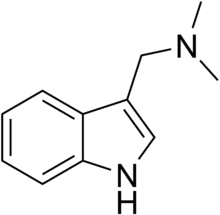Gramine
Gramine (also called donaxine) is a naturally occurring indole alkaloid present in several plant species. Gramine may play a defensive role in these plants, since it is toxic to many organisms.[1]
 | |
| Names | |
|---|---|
| IUPAC name
3-(Dimethylaminomethyl)indole | |
| Other names
donaxine | |
| Identifiers | |
3D model (JSmol) |
|
| ChEBI | |
| ChEMBL | |
| ChemSpider | |
| ECHA InfoCard | 100.001.591 |
| EC Number |
|
| KEGG | |
PubChem CID |
|
| UNII | |
CompTox Dashboard (EPA) |
|
| |
| |
| Properties | |
| C11H14N2 | |
| Molar mass | 174.24 g/mol |
| Melting point | 138 to 139 °C (280 to 282 °F; 411 to 412 K) |
| Hazards | |
| NFPA 704 (fire diamond) | |
Except where otherwise noted, data are given for materials in their standard state (at 25 °C [77 °F], 100 kPa). | |
| Infobox references | |
Occurrence
Gramine has been found in the giant reed, Arundo donax,[2][3]Acer saccharinum (Silver Maple),[4] Hordeum,[1][3] (a grass genus that includes barley) and Phalaris[3](another grass genus).
Effects and toxicity
Gramine has been found to act as an agonist of the adiponectin receptor 1 (AdipoR1).[5]
The LD50 of gramine is 44.6 mg/ kg iv in mice and 62.9 mg/ kg iv in rats.[6] Numerous studies have been done on the toxicity in insects harmful to crops for use as a possible insecticide.[7]
gollark: Make suicide punishable with the death penalty!
gollark: Technically, it's paid-for-by-other-people university.
gollark: The vonnegut thing, that is.
gollark: I wouldn't support it unless you did actually have to wait a while to make sure you really do actually want to die.
gollark: Yes. Free university education for inmates but nobody else.
References
- Corcuera, L. J. (1993). "Biochemical Basis of the Resistance of the Barley to Aphids". Phytochemistry. 33 (4): 741–747. doi:10.1016/0031-9422(93)85267-U.
- Orechoff, A.; Norkina, S. (1935). "Über die Alkaloide von Arundo Donax L.". Berichte der Deutschen Chemischen Gesellschaft. 68 (3): 436–437. doi:10.1002/cber.19350680312.
- Cheeke, P. R. (1989). Toxicants of Plant Origin, Alkaloids. CRC Press. p. 172. ISBN 0-8493-6990-8.
- Pachter, I. J.; Zacharias, D. E.; Ribeiro, O. (1959). "Indole Alkaloids of Acer saccharinum (the Silver Maple), Dictyoloma incanescens, Piptadenia colubrina, and Mimosa hostilis". Journal of Organic Chemistry. 24 (9): 1285–1287. doi:10.1021/jo01091a032.
- Sun Y, Zang Z, Zhong L, Wu M, Su Q, Gao X, Zan W, Lin D, Zhao Y, Zhang Z (2013). "Identification of adiponectin receptor agonist utilizing a fluorescence polarization based high throughput assay". PLoS ONE. 8 (5): e63354. doi:10.1371/journal.pone.0063354. PMC 3653934. PMID 23691032.
- Erspamer, V. (1954). "Pharmacology of Indolealkylamines". Pharmacological Reviews. 6 (4): 425–487. PMID 13236482.
- Corcuera, L. J. (1984). "Effects of Indole Alkaloids from Gramineae on Aphids". Phytochemistry. 23 (3): 539–541. doi:10.1016/S0031-9422(00)80376-3.
This article is issued from Wikipedia. The text is licensed under Creative Commons - Attribution - Sharealike. Additional terms may apply for the media files.
